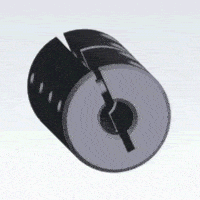What Is Shaft Coupling Windup and Backlash?
Rigid shaft couplings connect two separate shafts by clamping onto their adjacent faces. When installed properly, the shaft coupling connects the shafts in a precise line that transfers rotary motion between the shafts without causing misalignment or breakage. However, there are two main obstacles to the perfect transfer of rotary motion:
- This occurs when the application of torque results in greater shaft rotation at one end compared to the other.
- Backlash is the unwanted reactive motion between connected mechanical parts that can break couplings or cause mechanical stress.
This blog explores the causes and effects of windup and backlash in shaft couplings.
What Is Torsional Rigidity in Shaft Couplings?
Windup, otherwise known as torsional deflection, occurs when torque is applied and the rotation of one end of the shaft is greater than the other end. This creates unequal torsional deflection that engineers have to consider as they set up feedback mechanisms. The varying load on the gears causes unequal wear. Torsional rigidity can also put stress on the coupling, leading to deformation, breakage, and a more frequent need for parts replacement.
What Is Backlash in Shaft Couplings?
Backlash occurs whenever mating parts in a system aren’t precisely aligned. In shaft coupling systems, the coupling may have a poor grip on each of the shafts, resulting in slight angles and unequal wear and stress on the system.
Shaft couplings can accommodate some degree of backlash, but it’s important to ensure that any backlash is well within the system’s threshold. For example, angular movements greater than 2° past the preferred angle are considered excessive backlash, and this can cause extreme wear, stress, and even breakage. Although not all backlash is bad, when the backlash is too great, it will result in erratic dial indicator and laser alignment readings. Operators should always reduce the backlash to within the 2° threshold before alignment begins.
There are different types of misalignment based on the resulting misalignment angle. These include:
- Angular misalignment. When the shafts of two coupled units form a wide ‘V’ or obtuse angle
- Parallel misalignment. When the shafts are parallel but one is slightly higher than the other
- Skewed misalignment. Involves both parallel and angular misalignment
Any type of misalignment can cause backlash on the mechanical parts. It can also reduce the overall efficiency of the rotary motion transfer. It’s important to choose the right type of coupling that can prevent misalignment in the first place. Rigid shaft couplings, along with precise installation and setup, can reduce the risk of parts slippage and skew during operation of the system.
Choose Stafford Manufacturing for Shaft Couplings and Mechanical Components
At Stafford Manufacturing, we specialize in manufacturing rigid shaft couplings and other types of specialty mechanical components for energy transfer, motion control, automation, and other systems. Our rigid shaft couplings are designed to optimize the transfer of rotary motion. Browse our selection of one-piece split clamp, two-piece split clamp, three-piece split clamp, and precision sleeve couplings, or contact our team to learn more about our capabilities and inventory.




